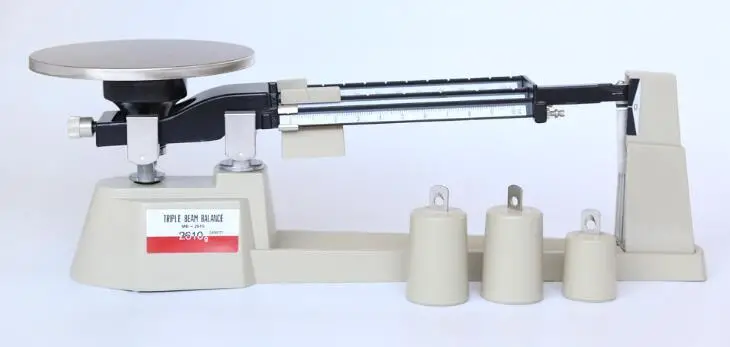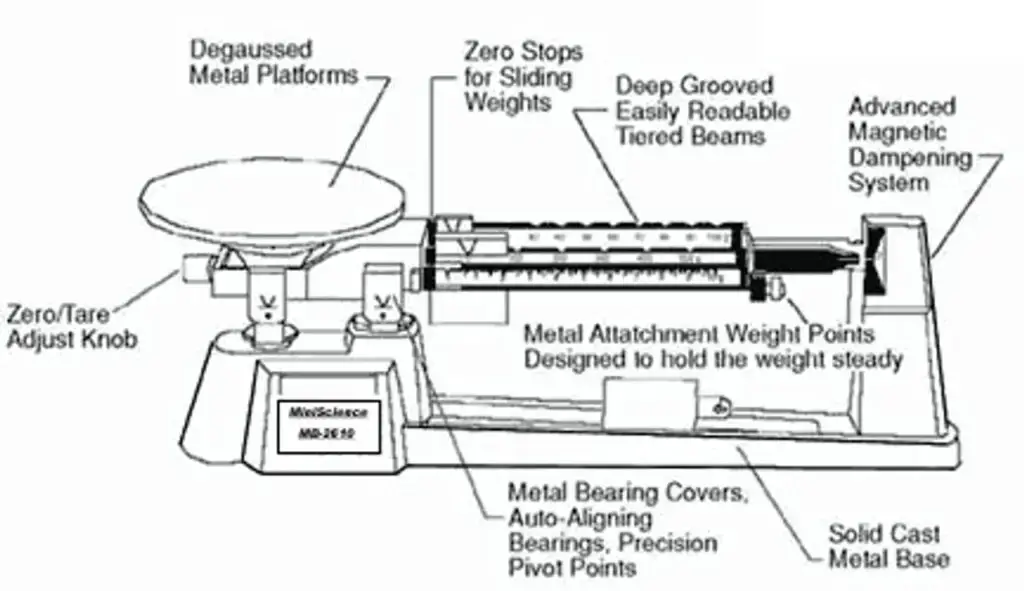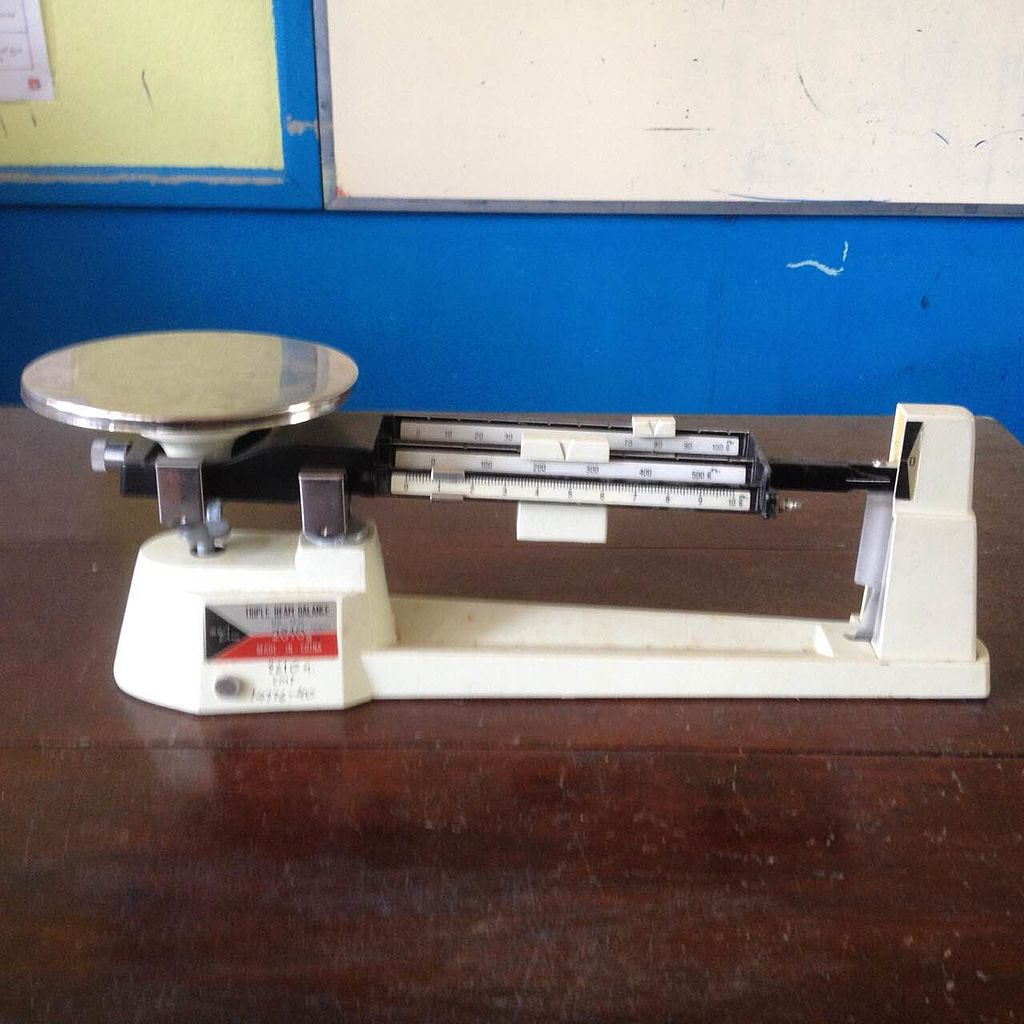What is Triple Beam Balance?
- Triple Beam Balance refer as a lab instrument, which used for measuring mass of object by comparison with known weights.
- The instrument is composed of three beams (100 g, 10 g and 1 g ranges) and a pan where the specimen is placed.
- The riders are slid along each beam until equilibrium is reached, the pointer is then aligned to zero for final reading.
- The working principle is stated as leverage and torque balance, where torques from mass on pan are countered by riders on beams.
- Calibration is done by zero adjustment knob before weighing, if not set, error will be introduced and reading will be wrong.
- The typical readability/precision of a classroom triple-beam is about ±0.1 g (sometimes shown as 0.1 g), accuracy depends on calibration and user.
- No electricity is required so the device is often preferred in field, school labs and places where power is absent.
- The parts are: pan, beams, riders, pointer, zero-adjust knob and base, these parts are maintained for long life if cleaned and protected from dust.
- Measurements are read by adding values of each rider (hundreds, tens, units) and the sum is recorded, students are taught this manually for learning mass concept.
- Parallax error, dust, uneven surface and air currents can cause slight deviations, this is often neglected but should be watched to prevail mistakes.
- Some models are equipped with magnetic damping for quicker stabilization, they help when object oscillation is present.
- Compared with electronic balance, the triple-beam is simpler and robust, but it is slower and less precise for very small masses.
- The instrument is used for solids, powders, small containers etc., and rarely for liquids unless they are put in tare-able vessel (like a beaker).
- Reading procedure is taught as: place object, set riders from largest to smallest, fine adjust last rider, then note sum; it is simple yet instructive.
- Triple beam balance are sturdy and hardy, they will last many years if calibration and handling are done correctly.
Definition of Triple Beam Balance
A triple beam balance is a precise measuring instrument used to determine the mass of an object. It consists of three beams, each with different sizes and scale readings, allowing for precise measurements ranging from 0.1 grams to 600 grams.

Parts of Triple Beam Balance With Diagram
1. Pan – The pan is flat metal plate where sample is placed for weighing, it is usually stainless steel (or aluminum) and sometimes circular.
2. Base- The base provide support to whole instrument, it is made sturdy and hardy, it keeps balance level on table.
3. Beams– Three beams are present (100 g, 10 g, 1 g) and are graduated with marks, they are mounted above pan and carry riders.
4. Riders – The riders are small sliding weights which are moved on beams to counterbalance unknown mass, values are added for final reading.
5. Pointer– A fine pointer is used to indicate equilibrium, when pointer meets zero mark the beams are said in balance, parallax error can occur.
6. Zero Adjustment Knob – The zero adjustment knob is provided near base for calibration, it is turned to set pointer exactly at 0 before weighing.
7. Support Pillar – A vertical support pillar hold the beam assembly above base, it keep alignment of lever arm and pan.
8. Fulcrum – A pivot or fulcrum is placed under beam which allow free rocking of beam, torque is balanced about this pivot.
9. Scale / Graduation Marks– The scale or graduation marks on beams are engraved or printed, they are read and summed (hundreds,tens,units) for mass value.
10. Damping device– Some models are fitted with magnetic damping / stabilizer which reduce oscillation and help pointer settle faster.
11. Pan Support / Clamp– The pan support or small clamp hold pan to beam assembly, it is adjusted sometimes for leveling, spacing may be uneven.
12. Case / Cover– A dust cover or case is used to protect parts when not used, it help to prevent dust and prolong life of instrument.

Operating Procedure of Triple beam balance

- The balance should placed on a flat and stable surface before use, uneven surface cause inaccurate reading and imbalance of pointer.
- The zero adjustment knob is checked and turned until pointer align exactly at zero mark when no object is on the pan.
- The pan should be clean and dry, dust or moisture must removed as it prevail error in mass measurement.
- The object / sample whose mass to measured is placed gently on pan without shaking or vibration.
- All riders are first set at zero position (left end) before starting measurement.
- The rider on the largest beam (100 g) is moved first one notch at a time till pointer drop below zero, then moved back one notch, showing weight is between that range.
- Then middle beam (10 g) rider is moved similarly to approach near balance point again.
- Lastly, the smallest beam (1 g or 0.1 g) rider is adjusted finely until the pointer come exactly to zero mark.
- The reading from all three beams are added together to obtain total mass of object.
- The pointer should oscillate slightly and settle at zero; if not, minor correction with smallest rider can done.
- After weighing, the sample is removed carefully and all riders returned back to zero to avoid damage.
- The balance should always kept covered or protected after use for preventing dust accumulation, corrosion or misalignment.
- Calibration by standard weight is done periodically to maintain accuracy, usually before each practical session.
- So, by following this sequence the triple beam balance operate correctly and give reliable measurement for laboratory or educational uses etc.
Advantages of Triple Beam Balance
- High Accuracy – The triple beam balance gives precise measurement of mass up to ±0.01 g in many models, so accurate reading are obtained even in basic laboratory condition.
- No Electricity Required – Operation of the balance does not depend on power supply, it can used anywhere / anytime which make it more reliable in field or outdoor studies.
- Simple Design – The structure is very simple and easily understandable by students, so training time for usage is less and error chances are reduced.
- Durability – The instrument made strong (usually metal body) and is very sturdy and hardy, hence long service life even after rough handling in classroom.
- Easy Maintenance – Since no electronic part is there, maintenance or repair work is easy, sometimes only cleaning and calibration needed for proper function.
- Direct Reading – Measurement can be directly observed by adding value of three riders, no complex digital system involved so no confusion of display or unit mismatch.
- Good for Teaching Purpose – Because of manual operation, it helps students understand mass balancing principle and lever arm concept more clearly than digital one.
- Low Cost – The cost of triple beam balance is cheaper compare with analytical or electronic balances, so it is economical for educational institutes.
- Reliable Performance – Under various temperature or humidity condition, result remain stable as no electronic drift occur, they show consistent reading.
- Portable and Compact – Light weight, small size, can be easily moved or carried to different places in lab, so flexibility is high.
- Magnetic Damping (in some) – Some models include damping system which help to prevail oscillation faster, leading to quicker equilibrium and reading.
- Versatile Use – It used for solids, powders, small containers etc., and sometimes liquid with container also can measured easily.
Limitations of Triple Beam Balance
- Manual Operation – The weighing process has to be done manually which take more time and care, especially when many samples are to measured.
- Limited Precision – Accuracy is only up to ±0.01 g or sometimes ±0.1 g, so not suitable for micro analysis or very small quantities.
- Human Error – Reading errors like parallax and wrong rider position often occur due to user’s mistake, it prevail accuracy and repeatability.
- Not Suitable for Liquid Directly – Liquids cannot weighed directly, a separate container has to used which sometimes add small error if not tared properly.
- Slow Measurement – Because balancing done step by step, the process become slow compare to digital balance where result displayed instantly.
- Requires Level Surface – The instrument must be placed on flat table for correct working, even small tilt cause error in pointer alignment.
- Bulky and Not Compact – Though simple in design but the balance occupy more bench space and is not very portable compared to modern compact ones.
- Environmental Sensitivity – Air current, vibration or temperature variation can influence reading slightly, which affect precision in lab condition.
- No Data Storage / Connectivity – Unlike digital balances, there is no feature to store, print or transfer data automatically, all recording done manually.
- Require Regular Calibration – Zero adjustment and calibration must be checked before every use otherwise drift in reading appear after time.
- Fatigue on Long Use – Continuous weighing cause user fatigue as adjustment of three riders repeatedly needed for each object, so less convenient.
Uses of Triple beam balance
- It used for measuring mass of solid materials, like small objects, powders or granules in laboratory works.
- The balance is often used in school / college laboratories for teaching students about concept of mass and weight determination practically.
- It applied for comparison of masses between different samples when high precision not required.
- In chemistry lab, it used for weighing reagents before preparation of solutions or mixtures.
- In biology experiments, small specimens, plant parts or containers with tissue samples are weighed before and after drying to check moisture content.
- In physics experiments, it helps to study principles of lever, torque and equilibrium etc., as it work based on those.
- The balance is used in field studies, where electricity is absent, to measure mass of soil or rock samples in environmental or earth science.
- It sometimes used in industrial training workshops to demonstrate basic weighing principles to students or trainees.
- Calibration testing of other small balances or scales can be done roughly by using it as reference mass device.
- The triple beam balance also used for weighing small containers or apparatus before experiment (tare weight) and after use to find mass difference.
- Some researchers use it in botanical / agricultural studies for measuring mass of seeds, grains and fruits etc., before germination or after harvest.
- So it serve as multi-purpose, dependable weighing tool which is still used widely in academic, research and field laboratory conditions.
FAQ
What is a triple beam balance?
A triple beam balance is a weighing instrument consisting of a pan for placing objects to be weighed and three beams with counterweights that allow for precise measurement of mass.
How does a triple beam balance work?
The triple beam balance works based on the principle of equilibrium. The counterweights on the beams are adjusted until the pointer aligns with the zero mark, indicating that the mass of the object on the pan is balanced by the counterweights.
What are the beams and counterweights on a triple beam balance used for?
The beams on a triple beam balance, each with its own set of counterweights, are used to measure the mass of an object. By adjusting the counterweights on the beams, the user can determine the mass by achieving balance.
What is the maximum weight a triple beam balance can measure?
Most triple beam balances can measure objects with a maximum weight of around 610 grams (or 2610 grams in some models).
What are the advantages of using a triple beam balance?
Some advantages of using a triple beam balance include its independence from electricity or batteries, long-lasting equilibrium, high accuracy in measuring mass, and cost-effectiveness.
Can a triple beam balance measure fractions or decimal values?
No, triple beam balances are primarily designed to measure in grams and do not provide precise measurements for fractions or decimal values.
Is calibration required for a triple beam balance?
Yes, periodic calibration is recommended to ensure the accuracy of a triple beam balance. Calibration should be performed using known weights to verify the balance’s measurements.
Can a triple beam balance be used for measuring large objects or heavy weights?
No, triple beam balances have a limited weight capacity and are not suitable for measuring large objects or heavy weights. They are designed for smaller items within their specified weight range.
How do you clean and maintain a triple beam balance?
To maintain a triple beam balance, it is important to keep the weighing pan clean and free of debris. Regular cleaning with a soft cloth or brush can help remove any particles that may affect measurements. Additionally, ensure that the balance is stored in a dry and stable environment to prevent damage.
Are triple beam balances commonly used in modern laboratories?
While triple beam balances are still used in some laboratories, electronic scales and other digital weighing instruments have become more prevalent due to their convenience and advanced features. However, triple beam balances continue to be valued for their durability, accuracy, and cost-effectiveness in certain applications.
- https://en.wikipedia.org/wiki/Analytical_balance
- https://www.physics.smu.edu/~scalise/apparatus/triplebeam/
- https://study.com/learn/lesson/triple-beam-balance.html
- https://www2.hawaii.edu/~johnb/micro/m140/syllabus/week/handouts/m140.1.2.html
- https://www.instructables.com/using-a-triple-beam-balance-with-uncertainty-analy/
- https://www.webassign.net/question_assets/tamucalcphysmechl1/lab_1/manual.html
- https://learning-center.homesciencetools.com/article/how-to-use-triple-beam-balance-science-lesson/
- https://files.plytix.com/api/v1.1/file/public_files/pim/assets/80/af/d5/5a/5ad5af80bc1f7d0473c16f75/texts/ec/cc/2c/5c/5c2cccec124f09050600ddae/TBB-DS-A4-EN.pdf
- https://files.plytix.com/api/v1.1/file/public_files/pim/assets/80/af/d5/5a/5ad5af80bc1f7d0473c16f75/texts/ea/cc/2c/5c/5c2cccea124f09050600ddaa/TBB_CM.pdf
- https://www.globalgilson.com/ohaus-triple-beam-balance
- https://beta-static.fishersci.com/content/dam/fishersci/en_US/documents/programs/scientific/brochures-and-catalogs/guides/ohaus-triple-beam-balance-trouble-shooting-guide.pdf
- https://www.ele.com/product/triple-beam-balance
- https://www.carolina.com/lab-balances-scales/carolina-triple-beam-balance/702020.pr
- https://www.flinnsci.com/api/library/Download/db841c44c5bc4d3abfb23ff5c6e73371
- https://el-gizmos.s3.amazonaws.com/materials/TripleBeamSE.pdf
- https://www.wisc-online.com/learn/natural-science/chemistry/gch202/reading-a-triple-beam-balance
- https://www.laddresearch.com/lanotattachments/download/file/id/206/store/1/triplebeampds.pdf
- https://en.wikipedia.org/wiki/Triple_beam_balance
- https://sciencing.com/difference-spring-scale-beam-scale-6821614.html
- https://sciencestruck.com/triple-beam-balance-function-parts-uses
- https://www.labmate.com/triple-beam-balance/lmtbb-a101
- https://www.hiweigh.com/wp-content/uploads/2017/07/MB-HiWEIGH-2018.pdf
- https://www.goultralow.com/best-triple-beam-balance/
- https://www.adamequipment.com/aeblog/an-introduction-to-education-scales-and-balances
- http://genchem.rutgers.edu/balance3b.html
- https://www.labtron.com/catalog/Triple-beam%20balance-LTBB-A10.pdf
- Text Highlighting: Select any text in the post content to highlight it
- Text Annotation: Select text and add comments with annotations
- Comment Management: Edit or delete your own comments
- Highlight Management: Remove your own highlights
How to use: Simply select any text in the post content above, and you'll see annotation options. Login here or create an account to get started.